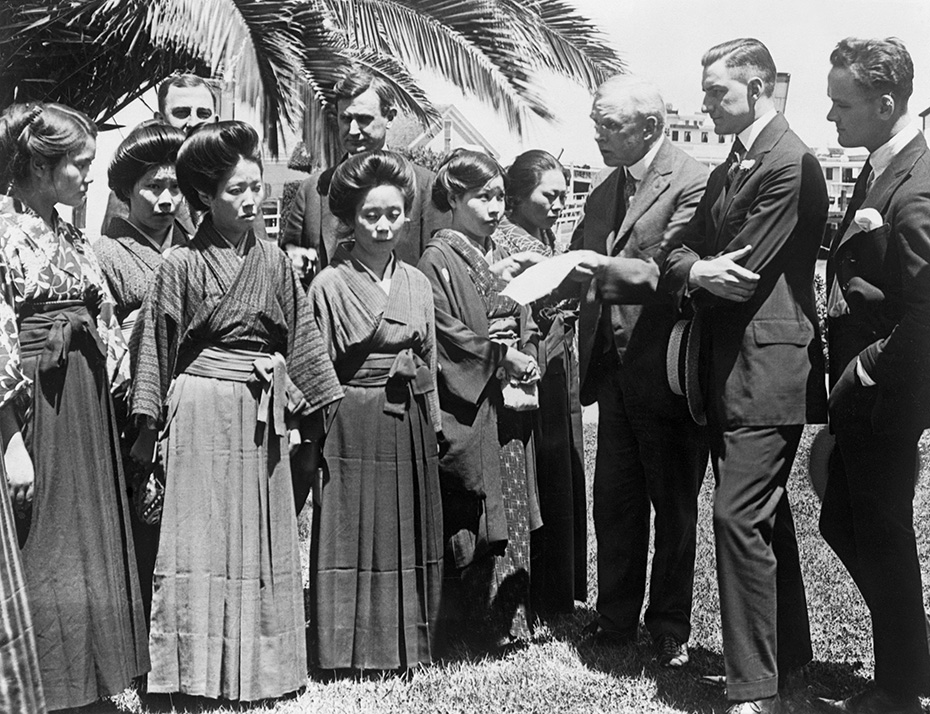Background
The 1907 Gentleman’s Agreement between the United States and Japan severely limited the entry of Japanese immigrants into America. However, the federal government made an exception for the Japanese wives of current American residents. The Japanese American community, which was mostly young single men, saw this as an opportunity. If a man married a woman who was in Japan, he could bring his new wife into the country legally. Matchmakers established a system where men reviewed pictures of single women seeking husbands in America. After a choice was made, the woman could set sail for America. These women, known as “picture brides,” made up the vast majority of Japanese immigrants between 1907 and 1924. By 1920, over 10,000 picture brides had arrived in the United States, and over 15,000 arrived in the then-territory of Hawaii. Picture brides played a crucial role in establishing the Japanese American community.
For many Japanese women, becoming a picture bride was a chance not only to fulfill the traditional obligation of marriage, but also to escape a life of poverty. But they did so at a great risk. Most picture brides did not speak or read English. Many were shocked when their new husbands were much older and poorer than they anticipated. Most picture brides worked for pay because their husbands did not make enough money to support two people, let alone any future children. Many of these women were also lured into unsafe environments, including abusive marriages or forced prostitution. Because anti-Asian sentiment was widespread at this time, many of them also faced racial discrimination throughout their lives.
About the Image
This image was taken at an immigration station in San Francisco, California, called Angel Island. The government officials (who are all white men) are reviewing the passports of newly arrived picture brides. After passing such a review, brides met their husbands for the first time and participated in a group wedding on the dock or at a nearby location. Holding an immediate wedding guaranteed the marriages and the women’s arrival were legal. By 1924, Japan stopped issuing passports to picture brides, which reassured the United States of Japan’s commitment to controlling immigration and closed the door to many would-be immigrants.
Vocabulary
- 1907 Gentleman’s Agreement: An informal agreement between the United States and Japan that limited the number of immigrants to the United States from Japan.
- matchmakers: People who arranged marriages.
Discussion Questions
- What do you notice about the newly arrived brides? Consider their body language and dress. Why might they look and feel that way?
- What do you notice about the government officials? Consider their gender, race, body language, and dress. What do these details tell us about who was controlling this system and how they felt about it?
- Picture brides took a tremendous risk in coming to the United States, and yet they came. What might this tell us about their lives in Japan or their hopes and expectations for life in America?
- Why were picture brides so important to establishing the Japanese American community?
Suggested Activities
- APUSH Connection: 6.8: Immigration and Migration in the Gilded Age
- Pair this image with Mira Edson Kohler’s article criticizing the Expatriation Act, another immigration-related policy enacted in 1907. Discuss how both the Expatriation Act and the Gentleman’s Agreement created unique challenges for women by linking immigration and citizenship to marriage.
- Learn more about anti-Asian immigration policy. Compare the Chinese Exclusion Act with the 1907 Gentleman’s Agreement by linking this photograph to accounts of women and families in the curriculum guide Chinese American: Exclusion/Inclusion (see Resource 20 and the life stories of Soto Shee and Linda Moy Chin).
- Consider how Asian immigrants resisted racist immigration restrictions in this era. Compare the Japanese picture bride system with that of Chinese paper sons and daughters, which is described in detail in the curriculum guide Chinese American: Exclusion/Inclusion (see Resource 18). How did each system work around immigration policy? What do these systems tell us about attitudes toward Asian immigration?
- Many picture brides were in their thirties and forties when World War II began and experienced incarceration with their husbands and children. Connect this image to the article about Japanese incarceration included in the curriculum guide WWII & NYC (see Resource C8).
Themes
IMMIGRATION, MIGRATION, AND SETTLEMENT
New-York Historical Society Curriculum Library Connections
- For more about restrictions on Asian immigration and Angel Island, see Chinese American: Exclusion/Inclusion.







